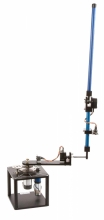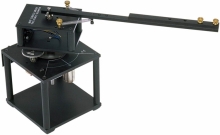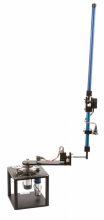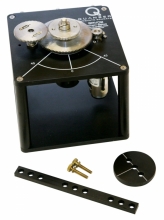The Rotary Double Inverted Pendulum module is ideal to introduce intermediate and advanced control concepts, taking the classic single inverted pendulum challenge to the next level of complexity. You can use it to demonstrate real-world control challenges related, for example, to takeoff stabilization of a multi-stage rocket. The Rotary Double Inverted Pendulum module attaches to the Rotary Servo Base Unit.
Control Systems
The standard in controls teaching and research.
Modeling & controls lie at the core of emerging technological breakthroughs. From drones to reusable rockets to self-driving vehicles, the fundamentals of modeling & control are a critical skill for engineers to compete and innovate.
Process Control
The modern industrial systems that are fundamental to modern automation and manufacturing processes require specialized control systems to perform and manage their daily operations. Quanser offers a variety of plants that can be used to teach the key elements of modern process control including cascade control with the Maglev and Ball and Beam systems as well as regulator design with the Coupled Tanks.
Classic Systems Control
The classic progression of control systems education begins with the fundamentals of modeling and designing control plants for linear systems. Quanser offers a diverse collection of plants that can be used as ideal platforms to offer students experience using classic control principles. These plants offer basic dynamics that range from rotary to linear motion.
Modern Systems Control
Quanser has a collection of plants that can be used to show how a modern approach to control systems allows for the creation of precise controllers for complex systems with higher-order dynamics. These plants include both dynamically complex plants such as the linear inverted pendulum, and double pendulum, as well as plants such as the active suspension that require the use of both state-space modeling to express the complex coupled dynamics of the system.
Unstable Systems
Some of the most exciting emerging technologies from bipedal walking robots to reusable rockets requires the design of controllers for unstable systems. Quanser offers several plants that give students an experience creating control systems for directly analogous dynamic systems.
-
-
The Rotary Flexible Joint module is ideal for modeling a flexible joint on a robot when mounted on the Rotary Servo Base Unit. It is also useful in the study of vibration analysis and resonance. This experiment uses a sensor to measure joint deflection, to address the control problems encountered in large, geared robot joints where flexibility is exhibited in the gearbox. Students will learn how to model the system using state-space and design a feedback controller with pole-placement.
-
The Rotary Flexible Link module is designed to help students perform flexible link control experiments. The module is designed to be mounted on the Rotary Servo Base Unit. This experiment is ideal for the study of vibration analysis and resonance and allows us to mimic real-life control problems encountered in large, lightweight structures that exhibit flexibilities and require feedback control for improved performance. The experiment is also useful when modeling a flexible link on a robot or spacecraft.
-
The Rotary Double Inverted Pendulum module is ideal to introduce intermediate and advanced control concepts, taking the classic single inverted pendulum challenge to the next level of complexity. You can use it to demonstrate real-world control challenges related, for example, to takeoff stabilization of a multi-stage rocket. The Rotary Double Inverted Pendulum module attaches to the Rotary Servo Base Unit.
-
The Rotary Servo Base Unit is the fundamental element of the Quanser Rotary Control experiments. It is ideally suited to introduce basic control concepts and theories on an easy-to-use and intuitive platform. Use it on its own to perform several experiments, or expand the scope of this unit by adding on other modules to teach an even wider range of control concepts.
Pages
- « first
- ‹ previous
- 1
- 2
- 3








